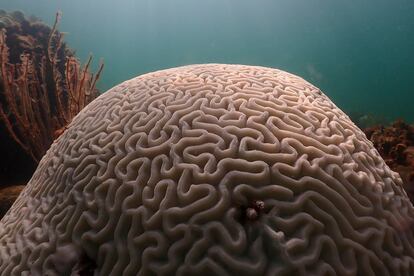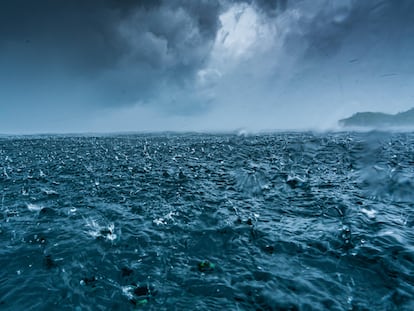Water at tip of Florida hits hot tub level, may have set world record for warmest seawater
The initial reading on a buoy at Manatee Bay hit 101.1 degrees (38.4 Celsius) Monday evening, according to National Weather Service meteorologist George Rizzuto

The water temperature on the tip of Florida hit hot tub levels, exceeding 100 degrees (37.8 degrees Celsius) two days in a row. And meteorologists say that could potentially be the hottest seawater ever measured, although there are some issues with the reading.
Just 26 miles (40 kilometers) away, scientists saw devastating effects from prolonged hot water surrounding Florida — devastating coral bleaching and even some death in what had been one of the Florida Keys’ most resilient reefs. Climate change has been setting temperature records across the globe this month.
Weather records for sea water temperature are unofficial, and there are certain conditions in this reading that could disqualify it for a top mark, meteorologists said. But the initial reading on a buoy at Manatee Bay hit 101.1 degrees (38.4 Celsius) Monday evening, according to National Weather Service meteorologist George Rizzuto. On Sunday night the same buoy showed an online reading of 100.2 (37.9 Celsius) degrees.
“It seems plausible,” Rizzuto said. “That is a potential record.”
While there aren’t official water temperature records, a 2020 study listed a 99.7 degree (37.6 Celsius) mark in Kuwait Bay in July 2020 as the world’s highest recorded sea surface temperature. Rizzuto said a new record from Florida is plausible because nearby buoys measured in the 98 and 99 (36.7 and 37.2 Celsius) degree range.
“This is a hot tub. I like my hot tub around 100, 101, (37.8, 38.3 Celsius). That’s what was recorded yesterday,” said Yale Climate Connections meteorologist Jeff Masters. Hot tub maker Jacuzzi recommends water between 100 and 102 degrees (37.8 and 38.9 Celsius).
“We’ve never seen a record-breaking event like this before,” Masters said.
But he and University of Miami tropical meteorologist Brian McNoldy said while the hot temperatures fit with what’s happening around Florida, it may not be accepted as a record because the area is shallow, has sea grasses in it and may be influenced by warm land in the nearby Everglades National Park.
Still, McNoldy said, “it’s amazing.”
The fact that two 100 degree measurements were taken in consecutive days gives credence to the readings, McNoldy said. Water temperatures have been in the upper 90s in the area for more than two weeks.
There aren’t many coral reefs in Manatee Bay, but elsewhere in the Florida Keys, scientists diving at Cheeca Rocks found bleaching and even death in some of the Keys most resilient corals, said Ian Enochs, lead of the coral program at the National Oceanic and Atmospheric Administration Atlantic Oceanographic and Meteorological Laboratory.
NOAA researcher Andrew Ibarra, who took his kayak to the area because of the hot water, said, “I found that the entire reef was bleached out. Every single coral colony was exhibiting some form of paling, partial bleaching or full out bleaching.”
Some coral even had died, he said. This is on top of bleaching seen last week by the University of Miami as NOAA increased the level of alert for coral problems earlier this month.
Until the 1980s coral bleaching was mostly unheard of around the globe yet “now we’ve reached the point where it’s become routine,” Enochs said. Bleaching, which doesn’t kill coral but weakens it and could lead to death, occurs when water temperatures pass the upper 80s (low 30s Celsius), Enochs said.
“This is more, earlier than we have ever seen,” Enochs said. “I’m nervous by how early this is occurring.”
This all comes as sea surface temperatures worldwide have broken monthly records for heat in April, May and June, according to NOAA. And temperatures in the North Atlantic are off the charts — as much as 9 to 11 degrees (5 to 6 degrees Celsius) warmer than normal in some spots near Newfoundland, McNoldy said.
Sign up for our weekly newsletter to get more English-language news coverage from EL PAÍS USA Edition
Tu suscripción se está usando en otro dispositivo
¿Quieres añadir otro usuario a tu suscripción?
Si continúas leyendo en este dispositivo, no se podrá leer en el otro.
FlechaTu suscripción se está usando en otro dispositivo y solo puedes acceder a EL PAÍS desde un dispositivo a la vez.
Si quieres compartir tu cuenta, cambia tu suscripción a la modalidad Premium, así podrás añadir otro usuario. Cada uno accederá con su propia cuenta de email, lo que os permitirá personalizar vuestra experiencia en EL PAÍS.
¿Tienes una suscripción de empresa? Accede aquí para contratar más cuentas.
En el caso de no saber quién está usando tu cuenta, te recomendamos cambiar tu contraseña aquí.
Si decides continuar compartiendo tu cuenta, este mensaje se mostrará en tu dispositivo y en el de la otra persona que está usando tu cuenta de forma indefinida, afectando a tu experiencia de lectura. Puedes consultar aquí los términos y condiciones de la suscripción digital.
More information
Últimas noticias
Most viewed
- Sinaloa Cartel war is taking its toll on Los Chapitos
- Oona Chaplin: ‘I told James Cameron that I was living in a treehouse and starting a permaculture project with a friend’
- Reinhard Genzel, Nobel laureate in physics: ‘One-minute videos will never give you the truth’
- Why the price of coffee has skyrocketed: from Brazilian plantations to specialty coffee houses
- Silver prices are going crazy: This is what’s fueling the rally










































